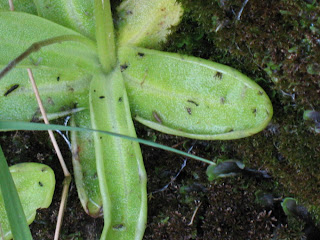


Butterworts, so called because they are alleged to coagulate milk, are investivorous perennials with solitary flowers and a basal rosette of leaves covered in slime. The common butterwort is one of three native butterwort species in the British Isles and has purple flowers and yellow-green leaves resembling a starfish. The common butterwort the leaf margins curl over insects and glands on the leaf secrete enzymes which digest the soft parts of their prey.
We have found hundreds of these plants on wet seepages on the near the seashore above Edern. I am not sure which of the two species we found, Common Butterwort (Pinguicula vulgaris) or the slightly smaller P. lusitanica which is said to occur in the west of the UK. I suspect they are the latter species as we did see these as small leaved "rosettes" all through the winter which is belive is the differance between vulgaris (no leaves showing in winter) and lusitanica.
The photos show the plant in flower, a patch of the plants growing in a wet seepage and a close up of the leaves showing the small insects trapped by the plants sticky leaves.



.JPG)

